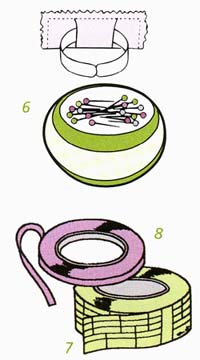|
These additional sewing aids help contribute to fine workmanship. They enable you to perform your hand tasks more quickly and easily. A seam ripper is a simple and safe pen-like device that allows careful ripping of adjustments and mistakes. Never, never use a razor blade as a substitute. (1) A loop turner is a specially designed tool with a latch-hook device at one end. It is used to turn tubing or bias cording to the right side. (2) |

A bodkin is used to draw elastic, belting and cording through casings. Gripper teeth or a safety pin closing hold the elastic or cording. Another type has an eye for threading and can be used for turning bias tubing. (3) A pointer and creaser is a flat wooden tool approximately 4” (10 cm) long. One end is pointed, the other is rounded. The pointed end is used for pushing out small corners; the rounded end is used in conjunction with an iron to flatten seamlines or to assist finger pressing. (4) A bias tape maker with the aid of an iron makes single-fold bias tape. Bias tape makers are available in ¼” to 2” (6 mm to 50 mm) sizes. (5) |
Are you looking for sewing or crafts-related items such as sewing machines, sergers, yarn, and knitting supplies? Try our online catalog pages here.
Or see what products on our site the popular search engines have chosen to list...
- Google listing of all "Sewing" items on our site
- Yahoo! listing
of all "Sewing" items on our site
- Alta Vista listing of all "Sewing" items on our site
Recommended Reading
Recommended Products
5 Drawer Foldaway Desk: Perfect for your sewing machine or serger! Constructed from durable melamine laminated particle board the Mobile Desks will offer a life time of reliable service.
If you need specific sewing supplies, browse through the products on pages like these:
- Brands of Overlock Serger Sewing Machines: Brother Serger and Coverstitch Machines and related items
- Singer Needles for Home Sewing Machines
- Industrial Sewing Machine Accessories

Pins and Pincushions are essential tools in any sewing room, be they used on the tabletop or on your wrist. We suggest having as many as you desire. At least one should be filled with fine emery for sharpening and removing rust from your needles and pins. Magnetic pincushions are available both for table and wrist use. They are useful when picking up loose pins that have fallen to the floor. (6)
Sewing tape is measured on one side to use as a stitching guide, especially when topstitching. One type can be separated into various widths. (7)
Basting tape is very narrow and has adhesive on both sides. Use it to hold a zipper in place or two layers of fabric for stitching. Do not stitch over tape and be sure to remove it after sewing the seam. (8)
Tissue paper should always be on hand. Use it when stitching those fabrics that may need special treatment to go through the feed dog and presser foot of your machine. The tissue is also used when lengthening your pattern tissue, making alterations, or transferring monograms and designs.
More Sewing Aids
These additional sewing aids help contribute to fine workmanship. They enable you to perform your hand tasks more quickly and easily.
Liquid seam sealant prevents fabrics from fraying. Use it to secure thread ends on buttonholes, serger seams, prevent fraying on seam allowances, or ends of ribbons. It’s also great for controlling runs in pantyhose. (1)
A magnetic seam guide attaches to the bed of the sewing machine next to the needle plate. Adjust it easily to ensure uniform stitching and seam allowances. (2)
A pocket curve template is used as a guide for pressing and stitching perfectly shaped pockets. Four pocket corners are on each template. (3)
An embroidery hoop is a two-part frame. One hoop fits snugly over another to hold a section of fabric taut for embroidery or beading. It can be purchased in both metal and wood, and in a variety of shapes and sizes. Select a hoop with a screw mechanism that permits adjustment for various weights of fabric. (4)
Beeswax should be kept handy in a holder to coat your hand sewing threads. It strengthens the thread and reduces tangling, knotting and breaking. (5)
A needle threader is a small device to help you on those frustrating days when you just can’t thread your needle. (6)
Iron cleaner is used to remove any residue left on the bottom of your iron after working with fusibles (7)